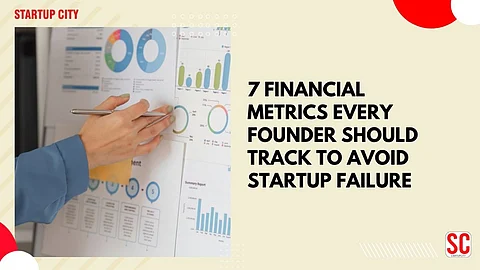

Let me tell you a truth many founders learn the hard way — great ideas don’t fail because of competition, they fail because of poor financial control.
Imagine building your dream startup, pouring your soul into it… and then watching it collapse, not because people didn’t love your product, but because you simply ran out of cash — or worse, didn’t even see it coming.
You're not alone if you’ve ever felt overwhelmed looking at a financial dashboard, unsure which metrics actually matter. I’ve been there too.
In this article, I’m going to break down the 7 financial metrics every founder should track to avoid startup failure — in plain English, with examples and clear, actionable takeaways.
If you're serious about scaling your startup, stay with me.
“A startup dies when it runs out of cash, not ideas.” — Paul Graham
Your burn rate tells you how much money you're spending every month before generating profits. It’s the heartbeat of your runway.
Helps you calculate how long your startup can survive without additional funding.
Reveals unsustainable spending early on.
Let’s say your monthly expenses are ₹10 lakhs and you have ₹1 crore in the bank. Your burn rate is ₹10 lakhs/month, which gives you a 10-month runway.
Pro Tip: Track both gross burn (total expenses) and net burn (expenses minus revenue) monthly.
Think of runway as your startup's oxygen supply. It answers one terrifyingly important question: “How many months can we operate before we run out of cash?”
Runway = Cash in Bank ÷ Net Burn Rate
Helps you time your fundraising round strategically.
Prevents last-minute cash crunches.
Do you know exactly how many months of runway your business has right now?
If not, now’s the time to find out.
For SaaS and subscription-based models, MRR is gold.
Offers predictable income.
Attracts investor interest.
Helps you forecast future growth.
New MRR: Revenue from new customers.
Expansion MRR: Revenue from upsells.
Churned MRR: Revenue lost due to cancellations.
In my experience, nothing calms investor nerves more than a strong, consistent MRR trajectory.
CAC tells you how much it costs to acquire one paying customer.
CAC = Total Sales & Marketing Expenses ÷ Number of New Customers Acquired
If you’re spending ₹10,000 to acquire a customer that only brings ₹5,000 in revenue, your growth is not just unscalable — it's dangerous.
Optimize campaigns that bring lower CAC.
Track CAC by channel (Google Ads vs LinkedIn vs referrals).
Here’s the secret: Smart founders track CAC weekly, not monthly. It’s that critical.
CLTV is the total revenue you expect from a customer during their entire relationship with your startup.
Helps evaluate long-term profitability.
Informs how much you should spend on CAC.
A CLTV:CAC ratio of 3:1 is ideal. If it’s lower, you’re overspending. If it’s higher, you might be under-investing in growth.
You’re running a D2C startup. Your average customer spends ₹1,500 monthly and stays for 12 months — your CLTV is ₹18,000. Now you know exactly how much headroom you have to spend on CAC.
Gross Margin shows how efficiently your startup is producing and selling products or services.
Gross Margin = (Revenue - Cost of Goods Sold) ÷ Revenue
Whether your pricing and production strategy is profitable.
How much is left to cover salaries, marketing, rent, and growth.
Tech startups often target 60–80% gross margin, while D2C or ecommerce may aim for 30–50% depending on the niche.
Bold truth: Gross margin is one of the first numbers investors ask for — because it tells the truth behind the hype.
“Revenue is vanity, profit is sanity, but cash flow is reality.”
Even profitable startups have died because of poor cash flow management. Why? Because money coming in and money going out are often out of sync.
Operating Cash Flow: Money generated from business activities.
Free Cash Flow: What's left after paying for capital expenses.
Use tools like QuickBooks or RazorpayX to track inflow/outflow weekly. Build a habit of cash flow forecasting — especially in uncertain markets.
You're not alone if this feels intimidating at first — but trust me, mastering this will make you a founder with true financial command.
Let’s be honest — tracking these 7 financial metrics won't guarantee success, but ignoring them almost guarantees failure.
As a founder, you wear many hats. But if there’s one thing you cannot afford to delegate blindly, it’s your startup’s financial health.
“What gets measured gets managed.” — Peter Drucker
My challenge to you? Take one day this week, sit with your team, and start reviewing each of these metrics. It could be the most important meeting of your company’s life.
Set up a simple dashboard using Google Sheets or tools like ProfitWell or Baremetrics.
Start tracking burn rate and runway weekly.
Schedule a monthly "Financial Health Check-In" with your co-founder or CFO.
Share this article with your leadership team.
Did this article help you? Want more actionable startup content like this? Let me know — I’m just a message away.